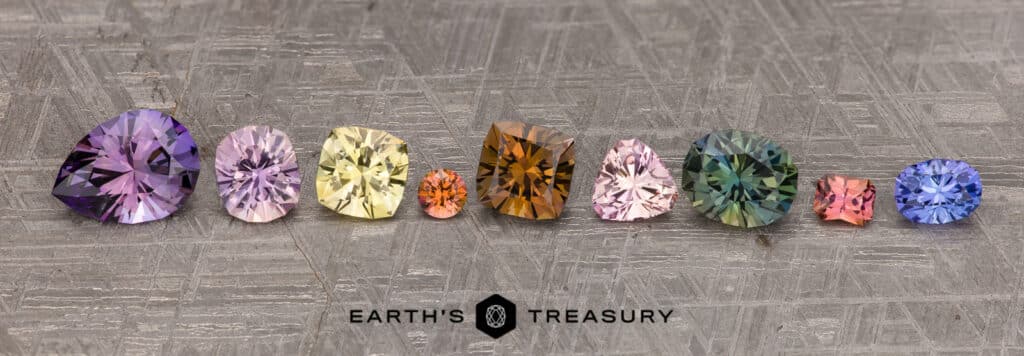Tanzanite
Overview
Tanzanite is a trade name for deep blue to violet zoisite, colored by the presence of trace amounts of the element vanadium. It was first discovered in 1967 in the Merelani Hills of Tanzania and was named and marketed by Tiffany’s. While zoisite is found around the world, and is sometimes even gem-clear, the only location where blue zoisite–tanzanite–is the Merelani Hills of Tanzania. Luckily the deposits are fairly large, so while tanzanite is rare, its plentiful enough to be a significant gemstone from a commercial perspective. Natural tanzanite is almost always a brownish-purple color; its heated to drive out the brownish and yellow tones and turn the stones the rich blue-violet color they are famous for. A very small amount of tanzanite is naturally this color, having been heated underground over the millennia. It’s a trichroic gem, which means that it shows different colors on each of three different optical axes, although heating will change most stones such that they are only dichroic. With its amazing blue color and excellent brilliance (it has a refractive index of 1.685 to 1.707), tanzanite makes a stunning gemstone; however, its relatively soft at 6.5-7 on the Mohs scale, and can easily abrade or chip. A proper mounting and good care can ensure that the gem stays in top condition.
Named Species/Varieties
There are no species or varieties of tanzanite.
Where is it found
Tanzanite is only found in the Merelani Hills of Tanzania.
Treatments
Most tanzanite has been heated to change it from a brownish color to the lovely deep blue to violet-blue the gem is famous for. The change is permanent. Because most tanzanite has been heated, there is little to no premium for unheated tanzanite gemstones.
Use in jewelry
As indicated earlier, the one shortcoming of tanzanite is that its not terribly hard. That means that it should be mounted in a way that can protect the gem from being easily chipped or abraded. Care should be taken when cleaning tanzanite; avoid the use of an ultrasonic jewelry cleaner.
Buy Tanzanite
You can browse our current inventory of loose Tanzanite gemstones here: Shop Tanzanite
Tanzanite Value Factors
Tanzanite is a highly sought-after gem for two reasons: its rarity (it is only found in one tiny area in the whole world) and its color range (a rich blue to violet-blue). Tanzanite is the trade name for blue-violet zoisite. However, while most well-known for its blue color, zoisite can be found in a range of hues—including pink, orange, and green—and many of them quite rare and highly collectible. While some vendors have tried to create their own grading systems for tanzanite, the reality is that there is no industry standard for grading tanzanite. These systems are all made up according to the whims of the vendor using them.
Here at Earth’s Treasury, we choose not to make up an arbitrary grading system that can’t be validated, so we will always describe our gems in terms of color and clarity. Some colors are more desirable and, therefore, more valuable, and the higher the clarity of a gem, the higher its value due to the higher rarity. Color is described based on hue, saturation, and tone.
Color
Hue
Hue or color is a large deciding factor in determining tanzanite value. This is because we inherently desire some colors more than others. In most parts of the world, rich shades of blue are very desirable. The most desirable forms of tanzanite are pure blue, though shades of violet and purple-blue are also highly sought after.
Saturation
While hue describes the main color of a gem, saturation refers to the intensity of that color. In general, the more saturated the color of tanzanite is, the more valuable it becomes, as the demand for the deep royal blues is high. Too much saturation, however, and tanzanite can become too dark, especially in a larger gem.
Tone
The final element of color that we see in a gem is the tone—you can think of it as a gray mask that makes the gem look darker and less vibrant, no matter the hue or saturation. In general, tanzanite has a lighter tone that ensures the vibrant blue and violet colors are not darkened; a darker tone that reduces this element will reduce the value.
Clarity
An important factor in determining the value of a tanzanite is the clarity—tanzanite is typically free of inclusions, so any inclusions present will detract from the gem’s value. If inclusions are present, they should not be visible to the naked eye. An exception is made for rare colors of fancy tanzanite or fancy zoisite, where the rarity is such that an inclusion can be overlooked.
Cut
Here at Earth’s Treasury, we specialize in fine custom cutting. The vast majority of tanzanite is cut in what is referred to as “commercial” grades, in which the focus is on weight retention, not on the best optical performance. We believe that every gem deserves fine precision cutting, not just diamonds. We create our own custom designs and optimize them for every type of gem we cut. As such, our tanzanite will have a sparkle and brilliance you won’t find elsewhere.
So, don’t get confused by the made-up AAA-type grading systems you’ll find elsewhere. When you’re looking for tanzanite, just focus on the color you want, make sure that the clarity is as clean as possible, and ensure the cut truly highlights the beauty of the gem. If you are looking for a wide selection of beautiful tanzanite gemstones for sale, you will find no better place than Earth’s Treasury.


